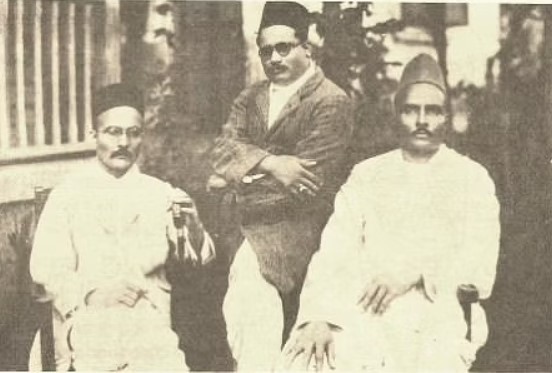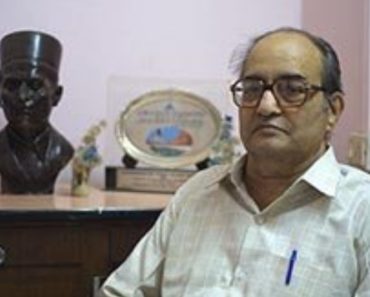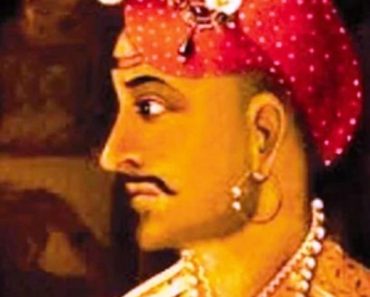Ganesh Damodar Savarkar popularly known as Babarao Savarkar (1879 – 1945) was an Indian revolutionary. He was a social activist and followed the nationalism ideology. The revolutionary freedom fighter Vinayak Damodar Savarkar was his younger brother. He was the founder of the revolutionary group ‘Abhinav Bharat Society,’ which he founded along with his brother Vinayak Damodar Savarkar in 1904. He was one of the founding members of the Rashtriya Swayamsevak Sangh (RSS).
Contents
Wiki/Biography
Ganesh Damodar Savarkar was born on Friday, 13 June 1879 (age 65 years; at the time of death) in Bhagur, Bombay Presidency, British India (present-day Maharashtra, India). His zodiac sign was Gemini. Soon after completing his Marathi education at a local school, he shifted to Nashik to pursue higher education in English. [1]Biography of Ganesh Savarkar Ganesh Damodar Savarkar started reading the texts of the books including Bharatkathasangraha, Pandavpra ap, Ramvijay, Harivijay, Shivleelaamrit and Jaimini Ashwamedha when he was a teenager. A mendicant named Balabuva used to teach him yoga mudras (yogic postures) when he was at Nashik for his higher studies. When he was thirteen years old, his mother died. A few years later, his father also died in a plague epidemic. At the age of twenty, being the eldest, he single-handedly started bringing up his three younger siblings.
Physical Appearance
Hair Colour: Black
Eye Colour: Black
Family & Caste
He belonged to the Chitpavan Brahmin community.
Parents & Siblings
His father’s name is Damodarpant Savarkar, and his mother’s name is Radhabai Savarkar. He had two brothers named Vinayak Damodar Savarkar and Narayanrao Savarkar. He had a sister named Mainabai.
Wife & Children
He got married to Yesubai Savarkar in 1896.
Their two children died in infancy. Ganesh Damodar Savarkar was detained in Andaman cellular jail when his wife, Yashoda died.
Revolutionary Activities
Ganesh Damodar Savarkar is known for persuading Indian youth to revolt against the British Raj in India. He believed in the armed revolution to attain freedom. He used to arrange and distribute weapons to the young Indian revolutionaries. During his involvement in the revolutionary activities, he managed to publish the biography of an Italian revolutionary named Mazzini. Ganesh Damodar Savarkar was a renowned freedom fighter who was the leader of an arm revolution against the British government in the Indian states of Bengal, Madras, and Punjab. In 1899, Vinayak Savarkar formed Rashtrabhaktasamooha, which was later renamed Mitramela. The members of Mitramela secretly made a revolutionary organisation and named it Abhinav Bharat. The members of Abhinav Bharat used to celebrate the Hindu festivals such as Dussehra by inviting other revolutionary freedom fighters for the celebrations. Ganesh Damodar Savarkar was a member of Abhinav Bharat and was the secretary of Lokamanya Tilak. On one such Hindu festival procession, the members of Mitramela organised a campaign on the streets of Nashik while chanting loudly the slogan “Vande Mataram.” Meanwhile, the protesters thrashed a British policeman who hit Babarao with a baton. The incident enraged the Britishers who reached the spot to arrest Babarao and his companions. They were tried, found guilty and penalised with a hefty fine. This was popularly known as the Vande Mataram trial.
Charges
Babarao was arrested for thrashing a sub-inspector Hussain, who was posted to control the crowd of the protest. Ganesh Damodar Savarkar was charged with organizing an illegal gathering; however, this case against him was dismissed. During the trial, he fought for himself as he did not arrange any advocate for him. He was sent to jail for a month for disobeying the Sub Inspector. Later, reportedly, a man named Gopal Krishna Gokhale leaked the information about the secret society Abhinav Bharat and its association with the Tilak to the British government. This led the Britishers to keep a secret eye through detectives on all the activities of Babarao and his residence. Soon, he was arrested in Mumbai where he had arrived to discuss the revolutionary plannings of his group. In the court trials, his book titled Laghu Abhinav Bharat Mala, a collection of 18 Poems, was presented as evidence against him to prove him guilty of provoking Indians against the British empire.
Trials and Judgement
The then Nashik District Collector, Jackson pronounced in his judgement on 8 June 1909 that Ganesh Damodar Savarkar was transported for life. Soon after his detention and imprisonment at Andamans in 1909, one of his revolutionary companions Anant Kanhare assassinated Jackson, the collector of Nasik, as revenge for Ganesh’s arrest. According to the Bombay High Court website, in 1909, Ganesh Damodar Savarkar was associated with the ‘Nasik Conspiracy Case.’ The Bombay High Court website claimed in one of its articles that the Savarkar brothers were the masterminds of the Nasik Conspiracy Case. It cited,
Among these thirty-eight persons, one was Vinayak Damodar Savarkar. From the evidence, it was clear that Savarkar (with his two brothers) was the brain, leader, and moving spirit of the conspiracy.”
Life in Andamans
In 1919, Ganesh Damodar Savarkar was diagnosed with Tuberculosis due to the ill-treatment and continuous torture provided to him at the cellular jail. The British government did allow him to get the basic treatment for the disease. Due to the contaminated food, Ganesh Damodar Savarkar fell severely ill in Andaman cellular jail. The Muslim wardens of the jail were serving the contaminated food to the Indian prisoners on the orders of Irish jailor, David Barrie. This incident provoked Ganesh Damodar Savarkar to hold a protest against the British government along with his fellow beings. In 1911, he met his younger brother Vinayak Savarkar in jail. Vinayak Savarkar was punished for providing armed weapons for the killing of Jackson.
Release from Jail
In 1921, on the plea of Bal Gangadhar Tilak and Surendranath Banerjee and public pressure, Ganesh Damodar Savarkar and Vinayak Savarkar were transported from cellular jail to Alipore jail in Calcutta. At the beginning of the following year, Ganesh was moved to Sabarmati jail from Alipore jail. During his detention at Sabarmati jail, he learnt that some pan-Islamists were conspiring to invite Amir-Amanullah of Afghanistan to attack India with the intention of invasion to drive the Britishers away. He wished to convey this information to all the Indians so that he could alert them of the Gandhi-Amanullah pact. He urged the British government to release him, but his deteriorated health conditions ruined his all plans, and the jail authorities hospitalised him in the third quarter of the year. Next year, his younger brother Narayanrao Savarkar filed a petition to the British government to release Ganesh Damodar Savarkar, and in September 1922, after thirteen years of severe imprisonment, Ganesh Damodar Savarkar was released from jail. When he came out of jail, he was in a critical stage and was on a stretcher.
Release from Jail
On 15th February 1931, Ganesh Damodar Savarkar met Mahatma Gandhi at Gandhi’s Ashram in Wardha. In a long conversation, Ganesh requested Mahatma Gandhi to seek the release of Bhagat Singh. However, Gandhi left with no answers to Ganesh’s questions as Gandhi wished for the path of ahimsa. Later, Ganesh Damodar Savarkar devoted his entire life to propagating the principles of Hindu Society. In one of his public speeches, Ganesh Savarkar claimed that he opposed the Hindu-Muslim unity ideology of Mahatma Gandhi. He said,
Freedom could not be won by pleadings and petitions, it could be attained by adopting a Russian-style terrorism if need be.”
Tarun Hindu Sabha
In 1923, Ganesh Damodar Savarkar established the ‘Tarun Hindu Sabha,’ a branch of the revolutionary group Hindu Mahasabha. To propagate the ideologies of Hinduism and his organisation, he travelled extensively for four to five years all across India. This organisation was open to anyone aged between 16-40. The new members of this group were allowed to join this organisation only after vowing to participate in the Shuddhi movement, which tried to inculcate the abolition of caste discrimination practices among the Indian youth and to train oneself in self-defence.
(Rashtriya Swayamsevak Sangh) RSS
In 1924, Ganesh Damodar Savarkar met Dr Keshav Balram Hedgewar, a former member of Anushilan Samiti, a revolutionary organisation, in Nagpur. After the meeting, Dr Keshav Balram Hedgewar left a good impression on Ganesh Savarkar, who entrusted the responsibility of Nagpur’s unit of Tarun Hindu Sabha to Dr Keshav Balram Hedgewar. In 1925, Dr Keshav Balram Hedgewar founded Rashtriya Swayamsevak Sangh (RSS). On the foundation occasion of RSS, Ganesh Savarkar was present at the function with the aim to unite Indian Hindus through RSS. The flag and the pledge of RSS were drafted by Ganesh Damodar Savarkar, along with the help of Dr Keshav Balram Hedgewar. The pledges of Abhinav Bharat and Tarun Hindu Sabha were also drafted by Ganesh Savarkar. Dr Keshav Balram Hedgewar often consulted Ganesh Savarkar in the workings of RSS. In April 1930, Ganesh Damodar Savarkar merged Tarun Hindu Sabha into the RSS and started working for the Sangh along with Dr Keshav Balram Hedgewar. Ganesh Damodar Savarkar used to travel with Dr Keshav Balram Hedgewar to different parts of Maharashtra to approach and urge other Hindu Nationalist organisations to merge into the Sangh.
Statements
In one of the articles of Hindu Janajagruti, an Indian website, it was cited that Babarao Savarkar was the pioneer to claim India as a Hindu nation. In one of his speeches, Ganesh Damodar Savarkar claimed,
Hindustan is a Hindu nation.”
Dhananjay Keer, an Indian biographer, stated in one of his books on Ganesh Damodar Savarkar that in 1909, the Nashik District Collector, Jackson worked as oppressive machinery of the British Empire and deported Babarao to the Andamans. Keer wrote,
part of the oppressive machinery of the British Empire” and “…responsible for deporting Babarao…”
Indian author and politician, M. J. Akbar stated in his book titled ‘India: The Siege Within’ that Babarao Savarkar co-founded the Rashtriya Swayamsevak Sangh (RSS) and later, merged his own organisation into RSS. Akbar wrote,
The five friends who started the RSS were Dr. B. S. Moonje, Dr. L. V. Paranjpe, Dr. Tholkar, Babarao Savarkar and Dr. Hedgewar himself.”
Literary Works
During his participation in the Indian independence movement, Babarao Savarkar used to contribute articles to well-known publications such as Kesari (Pune), Lokamanya (Mumbai), Maharashtra (Nagpur), Sakaal (Mumbai), Aadesh (Nagpur), and Vande Mataram (Mumbai). He was a voracious reader and accomplished author who used to write a diary during his detention period. His first book was ‘Rashtramimansa va Hindusthanche Rashtraswaroop’ (Analysis of the concept of nation and the nature of India’s nationhood), a Marathi book. His other writings include ‘Hindu Rashtra- Poorvi, aataa, aani pudhe’ (Hindu Rashtra – past, present, and future) and ‘Christ Parichay.’ ‘Christ Parichay’ was a disputable book in which he asserted that Christ was born Hindu. In 1938, an Indian author Golwalkar published a book titled “We, and our Nationhood, Defined,” which was based on the ideology of nationalism and Ganesh Damodar Savarkar’s essay “Rashtra Mimansa.” In Rashtra Mimansa, Ganesh Damodar Savarkar focussed on systematically explaining the ideological statements of the Rashtriya Swayamsevak Sangh (RSS).
Death
Ganesh Damodar Savarkar died on 16 March 1945 at Sangli, Bombay Presidency, British India (present-day Maharashtra, India) due to prolonged illness. [2]Haritambhara
Facts/Trivia
- He is well-known by the name Babarao. [3]Haritambhara
- Reportedly, after learning yoga mudras (yogic postures) during his higher studies at Nashik, he used to spend 14-15 hours daily practising yoga.
- Ganesh Damodar Savarkar had knowledge of Ayurveda, Samudrikas, Sastras, Astrology, Yoga, and Vedanta.
- The wife of Ganesh Damodar Savarkar spent the rest of her life at Rambhau Datar’s house after Ganesh was transported to the Andamans. Both families were close to each other, and she was alone as she lost two of her children in infancy. According to some media sources, the poetic letter ‘Saantvan’ was dedicated by Vinayak Savarkar when he was in England to his sister-in-law to console her.
- On 4 July 1911, Ganesh Damodar Savarkar met his brother Vinayak Damodar Savarkar after two years of his (Ganesh’s) imprisonment at cellular jail.
- On 21st December 1909, Kanhere, along with Karve, and Deshpande, killed Jackson, who sentenced Ganesh Damodar Savarkar to life imprisonment. Later, these three were tried and executed.
- In 1952, after seven years of Babarao’s death, Vinayak Damodar Savarkar ceased all the workings of the Abhinav Bharat Society and disbanded it.
- According to some media sources, Pandurang Bapat, a prominent figure in the Indian independence movement, taught the bomb-making techniques to Ganesh Damodar Savarkar on the advice of Vinayak Savarkar.
- Ganesh Damodar Savarkar was a follower of the teachings of Swami Vivekananda and Swami Ramtirtha. He used to perform Hindu religious activities for long hours and was a religious man who believed in worshipping Hindu Gods.
- In 1948, Nathuram Godse assassinated Mahatma Gandhi. Soon after this incident, the RSS organisation and his brother Vinayak Damodar Savarkar were charged as suspects in Gandhi’s assassination. This suspicion led to the ban of RSS. However, in 1949, the ban on RSS was also uplifted soon after Vinayak Savarkar was cleared from all the murder charges.
- Vinayak Damodar Savarkar installed a statue of his elder brother Ganesh Savarkar in Maharashtra after Ganesh’s death in his honour.
References
| ↑1 | Biography of Ganesh Savarkar |
|---|---|
| ↑2, ↑3 | Haritambhara |




















